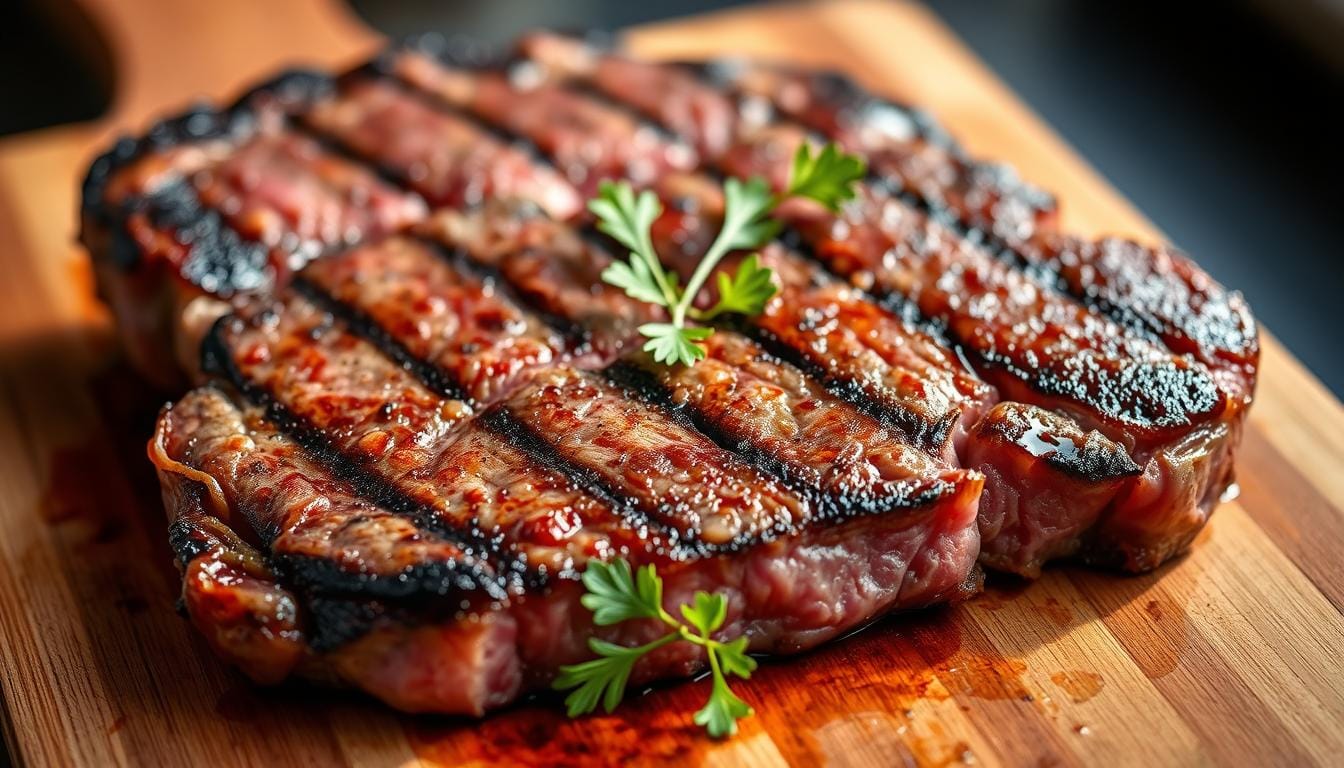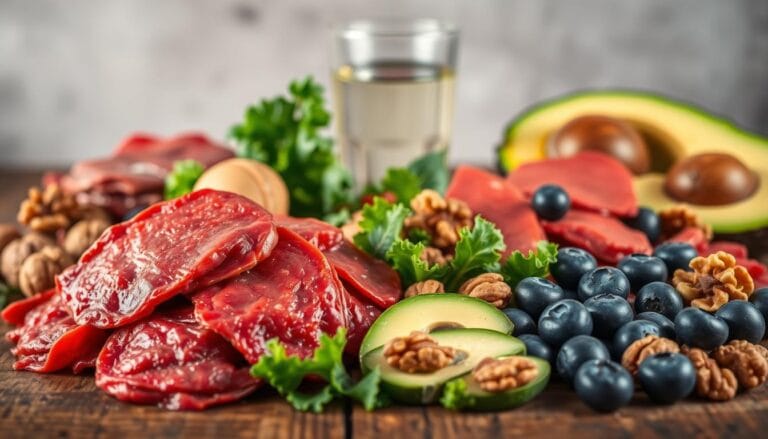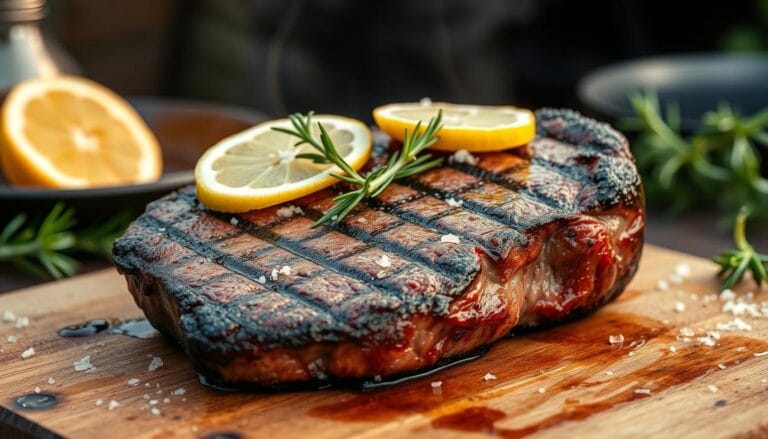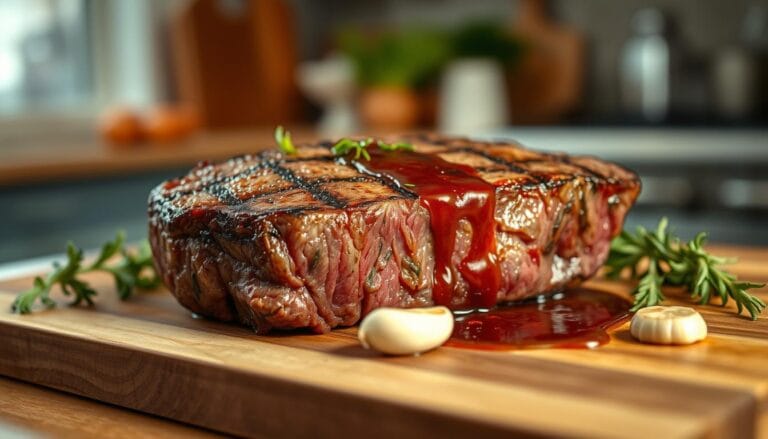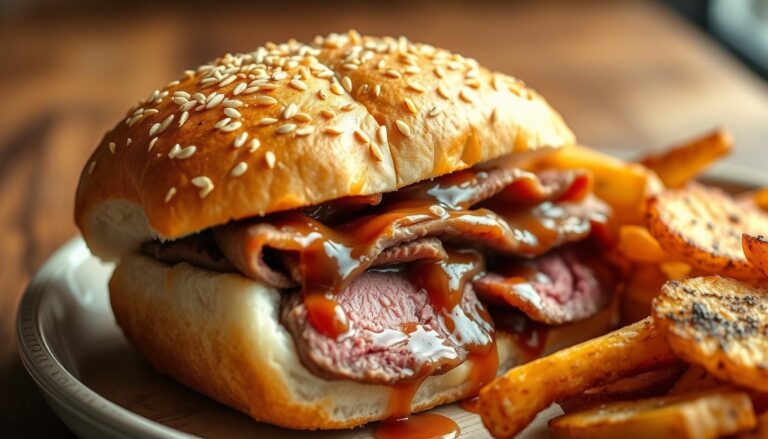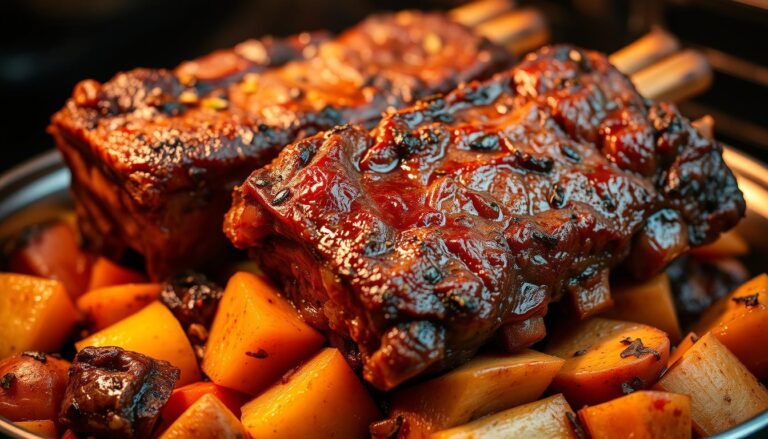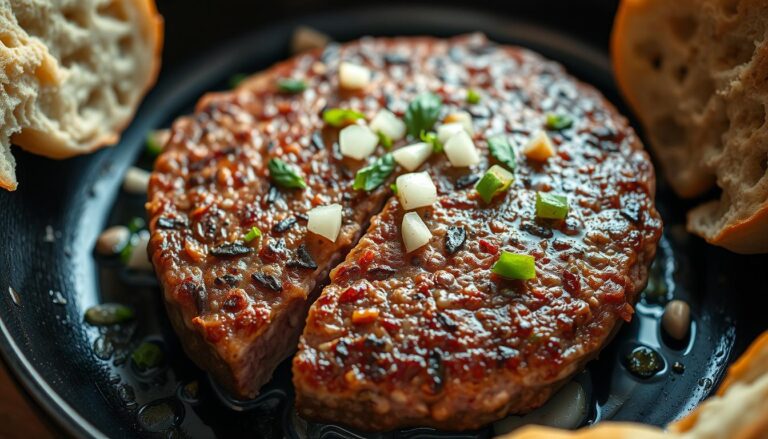Beef Teres Major: The Butcher’s Best-Kept Secret Cut of Steak
Table of Contents
Beef Teres Major: The Butcher’s Best-Kept Secret Cut of Steak
Imagine slicing into a tender, juicy piece of meat that’s full of flavor. The beef teres major offers just that, making it a cut above the rest.
This lesser-known cut is gaining popularity among chefs and home cooks alike. It’s known for its exceptional tenderness and versatility in various cooking methods, including grilling.
As a “butcher’s secret,” the teres major is now becoming a sought-after choice. It’s perfect for those looking to elevate their culinary repertoire without breaking the bank.
Key Takeaways
- Discover the exceptional tenderness and juiciness of the beef teres major.
- Learn about the versatility of this cut in various cooking applications.
- Understand why it’s gaining popularity among chefs and home cooks.
- Explore the value it offers compared to more common cuts.
- Get insights into cooking methods that work well with teres major.
What is Teres Major and Where Can You Find It?
The teres major is a lesser-known cut of beef. It’s full of flavor and tender. This cut comes from the cow’s shoulder, in the chuck primal area.
Definition and Characteristics
The teres major is a muscle that weighs about 8-12 ounces when trimmed. It’s tender, despite being from the shoulder. This makes it a great choice for those looking for tender beef without the high cost.
Tenderness is what makes the teres major special. It’s also known as the “petite tender” or “shoulder tender.” Its flavor profile is rich and beefy, loved by chefs and food lovers.
Location on the Cow
The teres major is found between the shoulder blade and the humerus. It’s part of the chuck primal. Butchers carefully remove this muscle, leaving a beautifully trimmed piece of meat.
Knowing where the teres major comes from helps us understand its tenderness. Its small size and location make it a great choice for meat lovers.
Comparison to Other Cuts
Compared to premium cuts like filet mignon, the teres major is just as tender and flavorful. But it’s more affordable. This makes it a great choice for those who want quality beef without spending a lot.
There are many ways to cook a teres major steak recipe. You can grill, slow cook, or use sous vide. No matter how you cook it, the teres major is sure to delight.
Why Choose Teres Major?
Looking for a cut that’s tender and full of flavor? Teres Major is a great choice. It stands out for many reasons.
Taste and Texture Profile
Teres Major has a robust beef flavor that’s more intense than tenderloin but stays tender. Its fine grain is like filet mignon but with a bit more chew. This makes it a pleasure to eat.
The texture is tender and has a satisfying mouthfeel. This enhances your dining experience. Whether you love beef or want to try something new, Teres Major will impress you.
Cooking Versatility
Teres Major is versatile in cooking. It works well with many techniques, from quick high-heat methods to slow cooking. This makes it perfect for many recipes.
- Grilling: Get a perfect sear on the outside and juicy inside.
- Slow Cooking: It becomes tender and falls apart easily.
- Sous Vide: It cooks evenly, ensuring every bite is great.
Its uniform shape ensures consistent cooking. This means every bite is as delicious as the last.
Health Benefits
Teres Major is nutritious and balanced. It’s leaner than many cuts but has enough marbling for flavor and juiciness.
| Nutritional Aspect | Teres Major | Other Beef Cuts |
|---|---|---|
| Protein Content | High | Variable |
| Fat Content | Moderate | High |
It’s not just tasty but also healthy. This makes it perfect for special meals and everyday dishes.
Cooking Techniques for Teres Major
The Teres Major is tender and juicy. It needs special cooking methods to bring out its flavor. Knowing how to cook it is key to enjoying this exceptional beef.
Grilling
Grilling is a favorite way to cook Teres Major. It gives a nice char on the outside and keeps the inside tender. Here’s how to grill it well:
- Preheat your grill to a high heat (around 450°F to 500°F) to achieve a good sear.
- Use a two-zone fire setup to manage flare-ups and cook the steak to your desired level of doneness.
- Cook for 4-6 minutes per side, or until you reach your desired internal temperature.
Tip: Use a thermometer to ensure the internal temperature reaches 130°F – 135°F for medium-rare.
Slow Cooking
Slow cooking is great for Teres Major. It makes the meat tender and fall-apart. Here’s how to slow cook it:
- Brown the Teres Major in a hot pan to create a flavorful crust.
- Transfer the browned Teres Major to a slow cooker or Dutch oven with your choice of aromatics and liquid.
- Cook on low for 8-10 hours or until the meat is tender and easily shreds with a fork.
Note: Use beef broth, wine, or a mix of both as the cooking liquid. Add onions, carrots, and celery for extra flavor.
Sous Vide
Sous vide cooking gives you precise control over the temperature. This ensures your Teres Major is cooked evenly. Here’s how to cook it sous vide:
- Season the Teres Major as desired, then seal it in a sous vide bag.
- Cook in a water bath at 130°F – 135°F for medium-rare, for 1-3 hours.
- Finish with a quick sear in a hot pan to develop a flavorful crust.
Tip: Use a cast-iron or stainless steel pan for the finishing sear, as they retain heat well.
Common Recipes Featuring Teres Major
The teres major cut is great for many dishes. It’s perfect for steak, tacos, and stir-fries. This makes it a favorite for both home cooks and chefs.
Teres Major Steak with Garlic Butter
Grilling teres major with garlic butter is simple yet fancy. Mix softened butter with garlic, parsley, and lemon juice for the butter. Grill it hot to keep juices in, then cook it low to get it just right.
Tips for preparation:
- Season the teres major with salt and pepper before grilling.
- Use a thermometer to ensure the internal temperature reaches your desired level of doneness.
- Let the steak rest for a few minutes before slicing and serving.
Teres Major Tacos
Thinly slice the teres major against the grain for tacos. Marinate it in citrus, chili powder, and spices for extra flavor. Top it with salsa, avocado, and sour cream in your tacos.
“The secret to great tacos is in the balance of flavors and textures. With teres major, you get a tender and juicy texture that pairs perfectly with a variety of toppings.”
Stir-Fried Teres Major with Vegetables
Stir-frying teres major is another great option. Slice it thin and freeze it to make cutting easier. Stir-fry it with bell peppers and broccoli, then season with soy sauce. Serve over rice or noodles.
| Recipe | Prep Time | Cook Time |
|---|---|---|
| Teres Major Steak with Garlic Butter | 15 minutes | 20 minutes |
| Teres Major Tacos | 20 minutes | 15 minutes |
| Stir-Fried Teres Major with Vegetables | 20 minutes | 10 minutes |
These recipes show how versatile teres major is. It can be grilled, made into tacos, or stir-fried. Teres major is sure to impress in any dish.
Pairing Suggestions for Teres Major
Find the best ways to enjoy teres major with wine, sauces, and sides. The right pairings can make this tender cut unforgettable. Whether you prefer classic or new ideas, we’ll show you how to create a delicious teres major steak recipe.
Ideal Wine Choices
For wine with teres major, choose medium to full-bodied reds. A Malbec or Syrah is great because of their rich flavors. Some Pinot Noirs with earthy notes also work well, thanks to their balanced tannins.
The secret is to match the wine’s tannins with the meat’s richness. A wine with moderate to high tannins can balance the meat’s fattiness, making the flavors harmonize.
Flavorful Sauces and Marinades
Try different sauces and marinades to boost your teres major. Chimichurri adds a fresh, herby taste, while red wine reductions offer a deep flavor. Compound butters add creaminess. For something unique, try a coffee-based rub or fruit-infused glaze.
Choose a sauce or marinade that complements the teres major’s natural flavors. Don’t be afraid to experiment with different ingredients to find the perfect match.
Side Dishes That Complement
Choosing the right sides can make your teres major meal complete. Roasted potatoes or ancient grains like quinoa or farro are great for starches. For veggies, roasted asparagus or grilled bell peppers add color and variety.
It’s all about balance. A tender teres major goes well with a mix of crunchy, smooth, and soft sides. This ensures a fulfilling meal.
| Pairing Category | Recommended Options |
|---|---|
| Wine | Malbec, Syrah, Pinot Noir |
| Sauces/Marinades | Chimichurri, Red Wine Reduction, Compound Butter |
| Side Dishes | Roasted Potatoes, Ancient Grains, Roasted Asparagus |
Purchasing Teres Major: What to Look For
The teres major cut is less common but offers a rich culinary experience. Knowing what to look for when buying it is key. Several factors can help you make an informed decision for a high-quality product.
Selecting Quality Cuts
Look for a bright cherry-red color when selecting a quality teres major cut. This color indicates freshness. The meat should have a fine texture and moderate marbling for tenderness and flavor.
Marbling is the intramuscular fat that adds to the meat’s taste and tenderness.
Fresh vs. Frozen Options
Choosing between fresh and frozen teres major depends on the freezing and thawing process. Vacuum-sealed packaging helps preserve quality. Frozen teres major, if handled correctly, can retain its original flavor and texture.
Understanding USDA Grades
The USDA grading system helps in making a purchasing decision. Relevant grades for teres major are Prime, Choice, and Select. Prime has the highest marbling and tenderness, perfect for grilling or roasting.
Choice is high quality but with less marbling than Prime. Select is leaner and may be less tender, but suitable for certain cooking methods.
| USDA Grade | Marbling Level | Tenderness | Best Cooking Methods |
|---|---|---|---|
| Prime | High | Very Tender | Grilling, Roasting |
| Choice | Moderate | Tender | Grilling, Pan-searing |
| Select | Low | Less Tender | Braising, Slow Cooking |
Labels like grass-fed, grain-finished, and organic also affect teres major’s flavor and texture. Grass-fed teres major is leaner and has a robust flavor. Grain-finished is often more tender and milder. Knowing these differences helps choose the right teres major for your cooking plans and preferences.
Storing Teres Major Properly
Keeping teres major tender and flavorful starts with the right storage. Whether you cook it right away or save it, knowing how to store it is key. This ensures it stays in top condition.
Best Practices for Refrigeration
For fresh teres major in the fridge, keep it below 40°F (4°C). Wrap it in butcher paper or a breathable material to avoid moisture buildup. Don’t use plastic wrap directly on the meat, as it can cause spoilage. If plastic wrap is needed, add a layer of butcher paper first.
Refrigeration Timeline: Enjoy your teres major within 3 to 5 days for the best taste and texture.
Freezing Tips for Freshness
Freezing extends teres major’s shelf life. Wrap it tightly in plastic wrap or aluminum foil, or use a vacuum sealer to prevent freezer burn. Freezing in smaller portions makes meal planning easier.
Freezer Storage: Teres major can last 6-12 months in the freezer. Mark packages with the date and contents to use the oldest first.
How to Thaw Safely
Thawing teres major safely is important to avoid bacterial growth. The best way is to thaw it in the fridge, which takes 6-24 hours depending on size. You can also thaw in cold water, changing the water every 30 minutes.
Thawing Tips: Avoid microwaving teres major to thaw, as it can cook unevenly and pose food safety risks. Cook it within a day or two after thawing.
| Storage Method | Duration | Tips |
|---|---|---|
| Refrigeration | 3-5 days | Wrap in butcher paper, keep at 40°F (4°C) or below |
| Freezing | 6-12 months | Wrap tightly, use vacuum sealer if possible, label packages |
| Thawing | 6-24 hours (refrigerator) | Thaw in refrigerator or cold water, cook within a day or two after thawing |
Teres Major in Different Cuisines
Teres major is a versatile cut found in many global cuisines. It’s perfect for chefs and home cooks who love to try new flavors. This cut can be adapted to many cooking styles.
American Classic Dishes
In American cuisine, teres major shines in comfort food dishes. Grill or pan-sear it and pair it with garlic mashed potatoes and steamed broccoli. It’s also a tasty alternative in pot roast recipes, cooking faster and staying juicy.
For a twist, season your grilled teres major with herbs and spices. Serve it with roasted potatoes and sautéed spinach. This dish is not only delicious but also nutritious.
Latin American Inspirations
Latin American cuisine is famous for bold flavors and grilling. Use teres major in carne asada recipes, marinated in lime juice, garlic, and spices. It’s also great for Brazilian churrasco, grilled with farofa and vegetables.
In Argentinian grilling, season teres major with chimichurri sauce. Grill it without overcooking to keep its juices. This makes for a tender and flavorful dish.
Asian-Inspired Recipes
Asian cuisine brings unique cooking techniques to teres major. For Korean barbecue, marinate it in a sweet and spicy sauce. Grill it for a tasty experience. It’s also good for Japanese hibachi, cooked with vegetables and served with steamed rice.
In Chinese cuisine, stir-fry teres major with vegetables and serve over rice. For a Thai dish, slice it thinly and mix it in a spicy salad with herbs, chilies, and lime dressing.
Nutritional Facts About Teres Major
Teres Major beef is known for its tenderness and nutritional value. It’s a great choice for your diet. Knowing its benefits helps you make better choices.
Protein Content
Teres Major beef is packed with high-quality protein. It has about 26-28 grams of protein per 4-ounce serving. This protein is complete, with all essential amino acids for muscle health and overall well-being. The high protein content is perfect for muscle support and feeling full.
Fat and Caloric Information
Teres Major is a leaner beef cut. A 4-ounce serving has about 6-8 grams of total fat, mostly unsaturated. It has a moderate calorie count, fitting into many diets, from keto to Mediterranean. Enjoying Teres Major beef as part of a balanced diet ensures a good mix of nutrients.
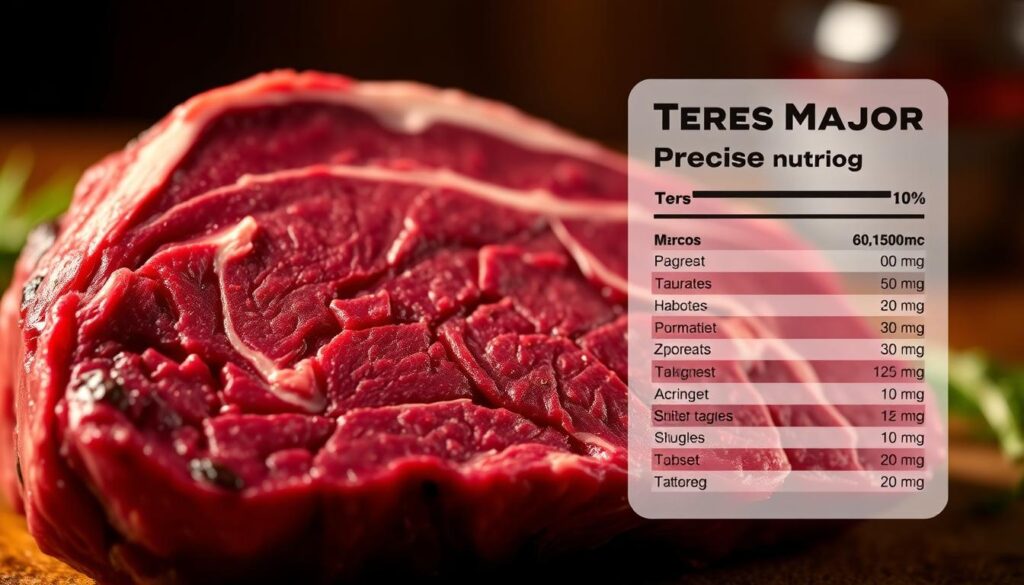
Vitamins and Minerals
Teres Major beef is full of important vitamins and minerals. It’s a top source of B vitamins, like B12, which is key for nerve function and red blood cell formation. It also has lots of zinc, iron, phosphorus, and selenium. These nutrients boost immune function, oxygen transport, and antioxidant defenses. Cooking methods like grilling or stir-frying help keep nutrients in.
- B Vitamins: Essential for energy production and nerve function.
- Zinc: Supports immune function and wound healing.
- Iron: Crucial for oxygen transport and preventing anemia.
- Selenium: Acts as an antioxidant, protecting cells from damage.
Adding Teres Major beef to your meals brings a delicious and nutritious protein source. It supports your health and well-being.
Comparing Teres Major to Other Cuts of Beef
Choosing the right beef cut is key in the kitchen. Teres Major is known for its tenderness and flavor. It’s often compared to other cuts to find the best choice.
Tenderloin vs. Teres Major
The tenderloin is loved for its soft texture and mild taste. Teres Major is tender too but has a stronger beef flavor. It has more fat, which makes it taste richer.
Teres Major is cheaper than tenderloin but just as tasty. It’s a good choice if you want flavor without breaking the bank.
Chuck Eye vs. Teres Major
Chuck Eye and Teres Major come from different parts of the cow. Chuck Eye is from the chuck section and is great for slow cooking. Teres Major is leaner and cooks faster.
Chuck Eye is best for slow cooking, while Teres Major works well with quick methods like grilling. Your choice depends on your cooking style and time.
Flank Steak vs. Teres Major
Flank Steak and Teres Major are different in grain direction and marinade needs. Flank Steak needs marinating, but Teres Major doesn’t.
Both can be sliced against the grain for tenderness. Teres Major is versatile and can be used in many dishes, from stir-fries to grills.
Teres Major: A Sustainable Choice
Choosing teres major recipes helps make our food system more sustainable. It’s important to know how our food choices affect the environment, society, and economy.
Environmental Impact of Beef
Beef production has big environmental impacts, like deforestation and greenhouse gas emissions. But picking lesser-known cuts like teres major can help reduce waste in the meat industry.
- Using more parts of the animal lowers demand for popular cuts, cutting down environmental harm.
- Supporting sustainable farming helps manage land better and preserves biodiversity.
Sourcing from Local Farms
Buying teres major from local farms has many benefits. Local farms often use more humane and sustainable methods. Plus, buying directly from them cuts down on transportation emissions.
Benefits of Local Sourcing:
- Less carbon footprint because of lower transport needs.
- Helps local economies and farmers.
- Animals are often treated better and raised more humanely.
The Benefits of Choosing Lesser-Known Cuts
“Nose-to-tail” eating means using the whole animal, cutting down waste and making food systems more efficient. Choosing teres major and other less common cuts helps achieve this goal.
The “nose-to-tail” method not only cuts down waste but also makes cooking more exciting by introducing new flavors and textures.
Some key benefits include:
- More varied culinary experiences through new recipes.
- Supports a more sustainable meat industry by valuing all cuts.
- Can be cheaper as these cuts are often less expensive.
By choosing wisely, like opting for teres major, you help create a more sustainable food future.
Tips for Perfecting Your Teres Major Dish
To make your beef teres major dish stand out, you need to get good at preparation. This means knowing how to marinate, season, and cook it right. These steps help bring out the best in this tender beef cut.
Marinating Techniques
Marinating is key for teres major, as it boosts flavor and tenderness. Because it’s naturally tender, a shorter marinating time works best. You should marinate it for at least 2 hours but no more than 24 hours.
The marinade should mix acids (like citrus or vinegar), oils, and herbs. Olive oil, garlic, and herbs like thyme or rosemary are great choices. The acid breaks down proteins, while oils and herbs add flavor.
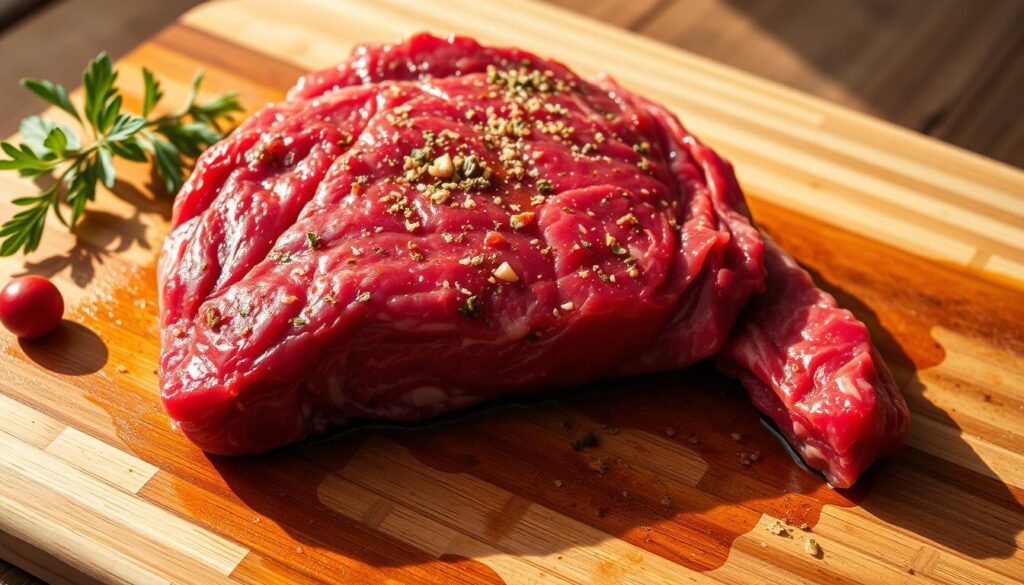
Seasoning Advice
Seasoning is also vital for a tasty teres major. Simple seasonings like salt, pepper, and paprika can really enhance the meat’s natural taste. For more complex flavors, try a spice blend that complements the beef without overwhelming it.
When to season matters too. You can season before cooking (dry rubs), during cooking, or as a finishing touch. Adding infused oils can also add extra flavor.
Cooking Temperatures
Cooking teres major to the right temperature is key for the perfect doneness. Use a meat thermometer for accuracy. For medium-rare, aim for 130°F to 135°F, medium is 140°F to 145°F, and well-done is 160°F and above.
Remember the carryover cooking effect, where the meat cooks a bit more after being removed from heat. Letting the teres major rest for 5 to 10 minutes before serving helps the juices redistribute. This makes it juicy and tender.
By mastering these techniques, you can make your teres major dish restaurant-quality. Whether grilling or using another method, paying attention to marinating, seasoning, and cooking details will make a big difference.
Frequently Asked Questions About Teres Major
Thinking about cooking teres major? You might wonder about its tenderness, how to cook it, and its uses in recipes. We’ll answer some common questions to help you enjoy this versatile cut.
Tenderness Concerns
Teres major is very tender, coming from the chuck section. Its tenderness comes from being a less-used muscle in the animal. This makes it perfect for those who love tender beef. The key to keeping it tender is proper preparation.
Cooking for Best Results
Cooking teres major needs careful attention because it’s lean. Here are some tips for the best results:
- Use a hot skillet to sear the teres major, locking in juices.
- Don’t overcook; teres major is best served medium-rare to medium.
- Let it rest before slicing to ensure tenderness.
| Cooking Method | Recommended Doneness | Cooking Time |
|---|---|---|
| Grilling | Medium-rare | 4-5 minutes per side |
| Pan-searing | Medium | 3-4 minutes per side |
| Sous Vide | Medium-rare | 1-2 hours at 130°F |
Exploring Alternative Uses
Teres major isn’t just for grilling or pan-searing. It’s great in many dishes, like:
- Ground beef applications, adding a tender texture.
- Tartare, for a raw beef experience, ensuring proper food safety.
- Carpaccio, thinly sliced and served with your favorite accompaniments.
- Beef Wellington or stuffed preparations, where its tenderness shines.
Understanding teres major’s characteristics and cooking methods opens up a world of culinary possibilities. This exceptional cut of beef is waiting to be explored.
Conclusion: Elevate Your Culinary Skills with Teres Major
Now that you’ve learned about Teres Major, you’re ready to improve your cooking. This tender cut is great for many dishes, from classic steaks to new fusion recipes.
Creative Kitchen Experimentation
Get creative with Teres Major. Try different flavors, cooking ways, and how you present it. Use marinades, seasonings, and sauces to bring out its taste.
Introducing Teres Major to Your Repertoire
Start sharing Teres Major with your loved ones. Make dishes that show off its steak-like taste. This will help you get better at cooking it and inspire others to try it too.
Sustainable Cooking with Teres Major
Choosing Teres Major is good for your cooking and the planet. It supports using the whole animal and cuts down on waste. This fits with today’s cooking trends and old food wisdom.
Keep exploring Teres Major and you’ll find new tastes, methods, and ideas to make your cooking better. With its rich taste and flexibility, it will soon be a favorite in your kitchen.
FAQ
What is teres major, and where does it come from?
Is teres major tough?
How do you cook teres major for best results?
What are some alternative uses for teres major?
How do I store teres major properly?
What are the nutritional facts about teres major?
How does teres major compare to other cuts of beef?
Is teres major a sustainable choice?
What are some tips for perfecting my teres major dish?
Can I use teres major in different cuisines?
How do I pair teres major with wine and side dishes?
For more cooking tips, stay connected with us. We also recommend the cookbook Skinnytaste Simple: Easy, Healthy Recipes with 7 Ingredients or Fewer
For more Recipes about Steak ?
Did You try our recipe ?
There are no reviews yet. Be the first one to write one.
